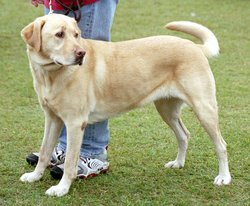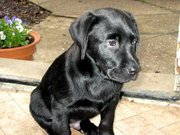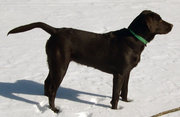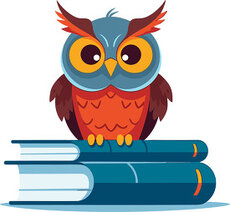Labrador Retriever
|
|
| Labrador Retriever | |||||||||||||||||||||
|---|---|---|---|---|---|---|---|---|---|---|---|---|---|---|---|---|---|---|---|---|---|
| Country of origin | |||||||||||||||||||||
| Newfoundland, (now part of) Canada | |||||||||||||||||||||
| Common nicknames | |||||||||||||||||||||
| Lab | |||||||||||||||||||||
| Classification and breed standards | |||||||||||||||||||||
|
The Labrador Retriever ("Labrador" or "Lab" for short), one of the most familiar breeds of dog, is noted for its friendliness, intelligence, and obedience. Because of these traits they are often trained to be gun dogs and assistance dogs, such as service dogs or guide dogs. Labrador Retrievers are the most popular breed of dog (by registered ownership) in both the United States and the United Kingdom.
Labrador Retrievers are one of several kinds of retriever.
| Contents |
Appearance
Labradors are relatively large with males typically weighing 60 to 80 lb (27 to 35 kg) and females 50 to 70 lb (23 to 32kg). They are energetic dogs, and are either black, yellow, or brown (called "chocolate") in color, in that order of frequency. The color is determined by two sets of genes - one determining coat color (black and yellow) and the other determining nose color (black and pink/brown). The black coat gene is dominant in both cases. Chocolate Labs are the result of the black coat color gene and a pink/brown nose color gene. Yellow Labs vary in color from white to light gold to a fox red. Their fur is usually fairly short and straight, and the tail quite broad and strong. The otter-like tail and webbed toes of the Labrador Retriever make him an excellent swimmer.
There are two types of Labrador Retrievers, the English and the America stock. English Labs are shorter and stockier with fuller faces than their American counterparts. No distinction is made by the AKC, but the two classification come from different breeding.
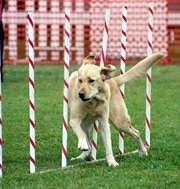
History
The Labrador originated on the island of Newfoundland, now part of the province of Newfoundland and Labrador, Canada. It is believed to have descended from the St. John's Water Dog, a crossbreed of native water dogs and Newfoundlands. The name Labrador was given to this dog by the Earl of Malmesbury and other breeders in England in order to differentiate them from the Newfoundland dog. The Labrador retriever was originally called the lesser Newfoundland or the St. John's dog.
The modern Labrador Retriever is among the oldest of the modern "recognized" breeds; according to the American Kennel Club, pedigrees exist back to 1878. The Kennel Club recognized the Lab in 1903. The first registration of Labradors by the AKC was in 1917; many English dogs were imported post WWI and these formed the foundation of the American variety.
Uses and activities
Labradors are a well-balanced breed, adaptable to a wide range of functions as well as making very good pets. As the name suggests, they are excellent at retrieving game, such as ducks, after the game has been shot. Their coat repels water to some extent, thus the extensive use of the dog in waterfowl hunting.
Labradors have a reputation as a mellow breed, but some lines (particularly those that have continued to be bred specifically for their skills at working in the field rather than for their appearance) are particularly fast and athletic. Most Labs enjoy retrieving a ball endlessly and other forms of activity, such as dog agility or flyball.

The steady temperament of Labs and their ability to learn quickly make them an ideal breed for assistance dogs.
Dog Pictures and Clipart
- Pictures of Dogs (http://classroomclipart.com/cgi-bin/kids/imageFolio.cgi?direct=Animals/Dogs)
- Dog Clipart (http://classroomclipart.com/cgi-bin/kids/imageFolio.cgi?direct=Clipart/Animals/Dog_Clipart)
Clipart and Animal Pictures
- Clipart (https://classroomclipart.com/image/category/clipart.htm)
- Animal Clipart (https://classroomclipart.com/image/category/animal-clipart.htm)
- Animal Animated Clipart (https://classroomclipart.com/clipart/Animations/Animals.htm)
- Pictures of Animals (https://classroomclipart.com/image/category/animal-photos.htm)
- Amphibian Clip Art, Pictures and Photogaphs (https://classroomclipart.com/image/category/amphibian-clipart.htm)
- Farm Animal Clip Art, Pictures and Photographs (https://classroomclipart.com/image/category/farm-animal-clipart.htm)
- Mammal Clip Art, Pictures and Photographs (https://classroomclipart.com/image/category/mammal-clipart.htm)
- Marine Animal Clip Art, Pictures and Photographs (https://classroomclipart.com/image/category/marine-life-clipart.htm)
- Reptile Clip Art, Pictures and Photographs (https://classroomclipart.com/image/category/reptile-clipart.htm)
- Spider Clip Art, Pictures and Photographs (https://classroomclipart.com/image/category/spider-clipart.htm)

